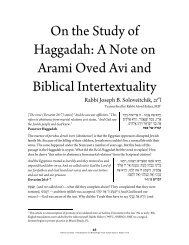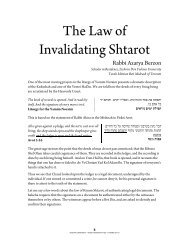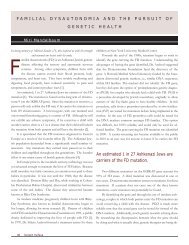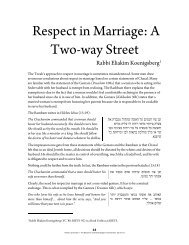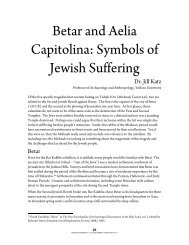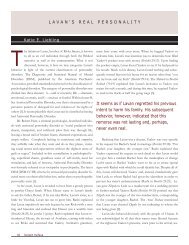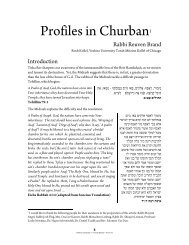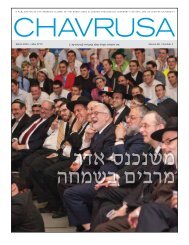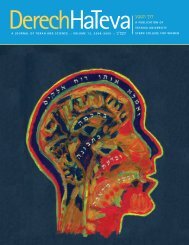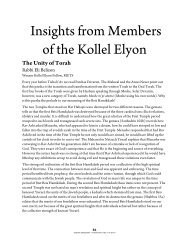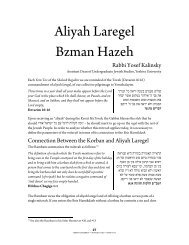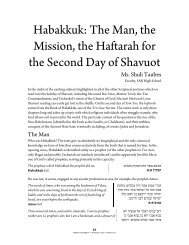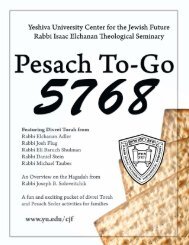YESHIVA UNIVERSITY • SUKKOT TO-GO ... - YU Torah Online
YESHIVA UNIVERSITY • SUKKOT TO-GO ... - YU Torah Online
YESHIVA UNIVERSITY • SUKKOT TO-GO ... - YU Torah Online
You also want an ePaper? Increase the reach of your titles
YUMPU automatically turns print PDFs into web optimized ePapers that Google loves.
Moshe Rabbeinu: An<br />
Angel Amongst Men10<br />
28<br />
<strong>YESHIVA</strong> <strong>UNIVERSITY</strong> <strong>•</strong> <strong>SUKKOT</strong> <strong>TO</strong>-<strong>GO</strong> <strong>•</strong> TISHREI 5771<br />
Ms. Miriam Krupka<br />
Faculty, The Ramaz Upper School<br />
Simchat <strong>Torah</strong> is arguably one of the happiest days of the Jewish calendar. It would seem to be<br />
incongruous, therefore, with the joy of the day, to be discussing issues of death and mourning.<br />
However, the central <strong>Torah</strong> reading of Simchat <strong>Torah</strong>, more specifically the final eight pesukim<br />
of Parshat VeZot Habracha, and thus, of the <strong>Torah</strong> itself, are a description of the death of (34:5-<br />
7), mourning for (8-9) and eulogy of (10-12), Moshe Rabbeinu. In fact, many of the piyyutim<br />
composed for the day of Simchat <strong>Torah</strong> are, in essence, hespedim for Moshe. 11<br />
Of course, reflections upon Moshe’s death on Simchat <strong>Torah</strong> are quite appropriate. Historians<br />
refer to the time period that the Jews spent in the desert as the “Mosaic period”, for after all,<br />
Moshe is the key element in the <strong>Torah</strong>’s revelation and the ubiquitous protagonist of 4/5 of the<br />
<strong>Torah</strong>. 12 In fact, God Himself declares that the <strong>Torah</strong> will be known for eternity by Moshe’s<br />
name, as Torat Moshe. 13 It is fitting that the text of the <strong>Torah</strong> should end with his death and in<br />
essence, by doing so, Moshe’s personal narrative is tied to that of the <strong>Torah</strong> itself. The question,<br />
therefore, is not why Simchat <strong>Torah</strong> is an appropriate day to celebrate the life and mourn the<br />
death of our great liberator, leader and lawgiver. What is compelling, however, is the way in<br />
which the <strong>Torah</strong>, and the various canons of aggadot treat the personhood of Moshe.<br />
The Issue of Moshe’s Celestial Status<br />
By ending chamisha chumshai <strong>Torah</strong> with Moshe’s death, the text strongly implies that the life<br />
and death of a single human being is the center or paradigm of the nation’s revelatory experience<br />
10 I would like to thank my colleagues at the Ramaz Upper School for their insightful comments on the earlier drafts<br />
of this article. In addition, I would specifically like to thank my friend Sefi Kraut for her astute and comprehensive<br />
review of the ideas contained herein.<br />
11 Hundreds of these piyyutim have been written across history and geography. One of the more renowned ones is<br />
the piyut written by Avraham Ibn Ezra, entited “Ashrecha”. It can be found in the Artscroll Sukkot machzor on page<br />
1347. For a comprehensive compendium and analysis of these piyyutim, see Leon Weinberger’s “The Death of<br />
Moses in the Synagogue Liturgy” (Brandeis University Ph.D, 1963)<br />
12 On a purely nominal level, his name appears over 600 times throughout Tanach. No other biblical figure has that<br />
much exposure, with the possible exception of King David. In addition, with Sefer Devarim, Moshe has more actual<br />
speaking time than any other figure in Tanach.<br />
13 Malachi 3:22, see Talmud Bavli, Masechet Shabbat 89a for the verse’s background.



